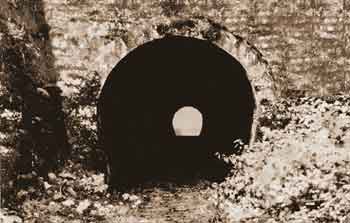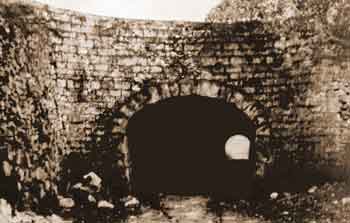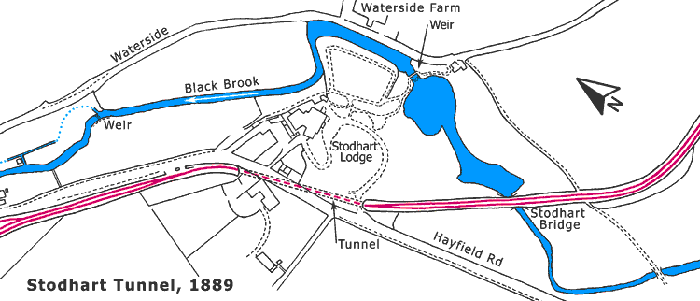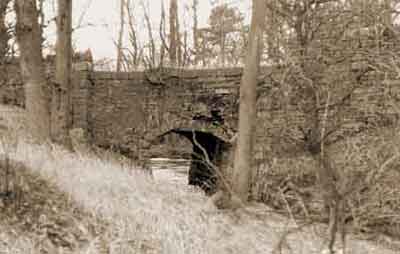

Stodhart Tunnel on the Peak Forest Tramway is situated between Stodhart Lodge and Stodhart Farm at Chapel Milton, Chapel-en-le-Frith, Derbyshire. At this point on the proposed line of the tramway there is a gritstone ridge and in 1795 Benjamin Outram and Thomas Brown were faced with the problem of either making an open cutting or a narrow-bore tunnel through it. In the end the owners of Stodhart Lodge, who had no desire to have an open tramway so close to their property, made the choice for them.
The civil engineering work involved in boring tunnels was well understood by this time and it was common practice on canals but this tunnel, which opened in 1796, is one of the earliest features of its kind on a feeder tramway to a canal.
The design of the tunnel was similar to the designs used on canal tunnels of the era with elliptical side walls, constructed of dressed gritstone. The portals at each end were built slightly later than the interior of the tunnel, a situation brought about by the owners of Stodhart Lodge who wanted it made longer in order to improve their privacy from the tramway.
As built, the tunnel was about 94-yards long and its height is 7 feet 6 inches. Its width at track level is 9 feet and at the spring of the arch it is 10 feet wide. Its width meant that it could only accommodate a single track. By 1803, due to an increase in trade, the track of the Peak Forest Tramway was converted from single to double-track operation but the tunnel was never widened and it remained in single-track operation throughout its working life. Because of this, the Peak Forest Canal Company, who owned the tramway, introduced special regulations for the passage of waggons through it. These caused hold-ups and, as a result, waggoners began to ignore them. As a consequence, one of the first recorded railway accidents happened here shortly afterwards. A gang of six loaded waggons were being hauled up the tramway in the direction of Chapel-en-le-Frith when they broke loose from the horse team and rolled back into the tunnel. Here they struck a two-horse team hauling empty waggons in the same direction. Both horses were killed and the waggoner's apprentice was seriously injured. It took several days to clear the tunnel and re-open the tramway.
The canal company held an enquiry into the causes of this accident and the apprentice was held responsible for causing the accident as he had failed to comply with the correct time interval between waggon gangs going through the tunnel.
In 1949, Hayfield Road (A624), which passes above the tunnel, was re-aligned in a road improvement scheme and this resulted in the loss of the northern portal and some of the tunnel. Nevertheless, the southern portal and a section of tunnel survived, together with its approach cutting.
Stodhart Tunnel is considered to be the second oldest surviving rail-related tunnel in Britain and because of its importance it is listed Grade II*, List Entry Number: 1334843. It is presently on the Heritage at Risk Register. Some of the lining stones are missing and repair and re-pointing work is needed but before this can be done it would need vegetation removal. Water is also penetrating the roof and the walls are bowing due to tree roots. The Stodhart Tunnel Preservation Trust was incorporated on the 21 March 2005.
It was understood that a programme of tunnel repair work and interpretation, including the provision of a viewing platform, was to be undertaken but nothing came of this plan.
The oldest surviving rail-related tunnel in Britain is Fritchley Tunnel, which is also in Derbyshire. This was situated on the Butterley Gangroad, which opened in 1793 and remained operational until 1935. This tunnel is a Scheduled Monument, List Entry No. 1422984.
 |
 |
| North Portal of Stodhart Tunnel, Sep 1928. This portal is no longer extant. | South Portal of Stodhart Tunnel, Sep 1928. |


Stodhart Bridge viewed looking downstream, Dec 1977
Left is to Stodhart Tunnel and right is to Townend and Chapel-en-le-Frith. This bridge is no longer extant.